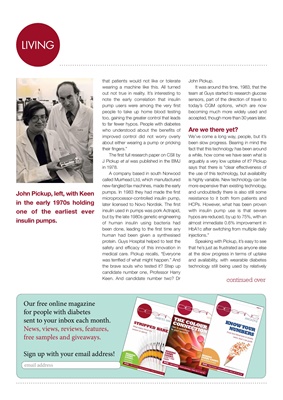
LIVINGLIVING
Our free online magazine
for people with diabetes
sent to your inbox each month.
News, views, reviews, features,
free samples and giveaways.
Sign up with your email address!
email address
that patients would not like or tolerate
wearing a machine like this. All turned
out not true in reality. It's interesting to
note the early correlation that insulin
pump users were among the very first
people to take up home blood testing
too, gaining the greater control that leads
to far fewer hypos. People with diabetes
who understood about the benefits of
improved control did not worry overly
about either wearing a pump or pricking
their fingers."
The first full research paper on CSII by
J Pickup et al was published in the BMJ
in 1978.
A company based in south Norwood
called Muirhead Ltd, which manufactured
new-fangled fax machines, made the early
pumps. In 1983 they had made the first
microprocessor-controlled insulin pump,
later licensed to Novo Nordisk. The first
insulin used in pumps was pork Actrapid,
but by the late 1980s genetic engineering
of human insulin using bacteria had
been done, leading to the first time any
human had been given a synthesised
protein. Guys Hospital helped to test the
safety and efficacy of this innovation in
medical care. Pickup recalls, "Everyone
was terrified of what might happen." And
the brave souls who tested it? Step up
candidate number one, Professor Harry
Keen. And candidate number two? Dr
John Pickup.
It was around this time, 1983, that the
team at Guys started to research glucose
sensors, part of the direction of travel to
today's CGM options, which are now
becoming much more widely used and
accepted, though more than 30 years later.
Are we there yet?
We've come a long way, people, but it's
been slow progress. Bearing in mind the
fact that this technology has been around
a while, how come we have seen what is
arguably a very low uptake of it? Pickup
says that there is "clear effectiveness of
the use of this technology, but availability
is highly variable. New technology can be
more expensive than existing technology,
and undoubtedly there is also still some
resistance to it both from patients and
HCPs. However, what has been proven
with insulin pump use is that severe
hypos are reduced, by up to 75%, with an
almost immediate 0.6% improvement in
HbA1c after switching from multiple daily
injections."
Speaking with Pickup, it's easy to see
that he's just as frustrated as anyone else
at the slow progress in terms of uptake
and availability, with wearable diabetes
technology still being used by relatively
continued over
John Pickup, left, with Keen
in the early 1970s holding
one of the earliest ever
insulin pumps.